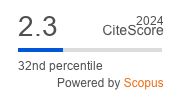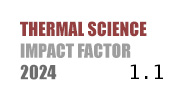THERMAL SCIENCE
International Scientific Journal
SIMULATING CHLORIDE PENETRATION IN FLY ASH CONCRETE BY A FRACTAL DERIVATIVE MODEL
ABSTRACT
In the real engineering field, the chloride ions behave abnormal diffusion phenomena in concrete caused by different compositions of the concrete which lead to the complex physical and chemical properties. This paper utilizes a fractal derivative model and a fractional derivative model to describe the diffusion phenomena. Furthermore, according to actual experimental data in the field, the fractional and fractal model can simulate the diffusion behavior of chloride ions in concrete. In comparison to the fractional derivative model, the fractal derivative model gives a simpler mathematical expression and lower calculation costs. In addition, the linear regression analysis method is used to establish an effective relationship between the internal composition of concrete and the parameters of fractal model such as fractal order α and diffusion coefficient D. As a result, the fractal model with the parameters estimated by above relationship can predict the diffusion behavior of chloride ions.
KEYWORDS
PAPER SUBMITTED: 2018-10-24
PAPER REVISED: 2018-11-03
PAPER ACCEPTED: 2018-11-20
PUBLISHED ONLINE: 2018-12-16
THERMAL SCIENCE YEAR
2019, VOLUME
23, ISSUE
Supplement 1, PAGES [S67 - S78]
- Collepardi, M., et al., The Kinetics of Penetration of Chloride Ions into the Concrete, Il cemento, 67 (1970), 4, pp. 157-164
- Nilsson, L. O., et al., Hetek. Chloride Penetration into Concrete. State of the Art, Transport Processes, Corrosion Initiation, Test Methods and Prediction Models, Denmark, ISSN/ISBN, (1996), pp. 0909-4288
- Chalee, W., et al., Predicting the Chloride Penetration of Fly Ash Concrete in Seawater, Marine Structures, 22 (2009), 3, pp. 341-353.
- Tang, L. P., Gulikers, J., On the Mathematics of Time-Dependent Apparent Chloride Diffusion Coefficient in Concrete, Cement and Concrete Research, 37 (2007), 4, pp. 589-595
- Stewart, M. G., Rosowsky, D. V., Time-Dependent Reliability of Deteriorating Reinforced Concrete Bridge Decks, Structural Safety, 20 (1998), 1, pp. 91-109
- Thomas, M. D. A., Bamforth, P. B., Modelling Chloride Diffusion in Concrete - Effect of Fly Ash and Slag, Cement and Concrete Research, 29 (1999), 4, pp. 487-495
- Maage, M., et al., Service Life Prediction of Existing Concrete Structures Exposed to Marine Environment, Aci Materials Journal, 93 (1996), 6, pp. 602-608
- Cai, W., et al., A Survey on Fractional Derivative Modeling of Power-law Frequency-dependent Viscous Dissipative and Scattering Attenuation in Acoustic Wave Propagation, Applied Mechanics Reviews, 70 (2018), 3, pp. 030802
- Liu, X. T., et al., A Scale-Dependent Finite Difference Approximation for Time Fractional Differential Equation, Computational Mechanics, (2018), pp. doi.org/10.1007/s00466-018-1601-x
- Sun, H. G., et al., Variable-Order Fractional Differential Operators in Anomalous Diffusion Modeling, Physica a-Statistical Mechanics and Its Applications, 388 (2009), 21, pp. 4586-4592
- Sun, H. G., et al., Use of a Variable-Index Fractional-Derivative Model to Capture Transient Dispersion in Heterogeneous Media, Journal of Contaminant Hydrology, 157 (2014), pp. 47-58
- Yin, D., Qu, P., Variable-Order Fractional Msd Function to Describe the Evolution of Protein Lateral Diffusion Ability in Cell Membranes, Physica A: Statistical Mechanics and its Applications, 492 (2018), pp. 707-714
- Chen, W., et al., A Variable-Order Time-Fractional Derivative Model for Chloride Ions Sub-Diffusion in Concrete Structures, Fractional Calculus and Applied Analysis, 16 (2013), 1, pp. 76-92
- Chen, W., Time-Space Fabric Underlying Anomalous Diffusion, Chaos Solitons & Fractals, 28 (2006), 4, pp. 923-929
- Chen, W., et al., Anomalous Diffusion Modeling by Fractal and Fractional Derivatives, Computers & Mathematics with Applications, 59 (2010), 5, pp. 1754-1758
- Sun, H. G., et al., A Fractal Richards' Equation to Capture the Non-Boltzmann Scaling of Water Transport in Unsaturated Media, Advances in Water Resources, 52 (2013), pp. 292-295
- Cai, W., et al., The Fractal Derivative Wave Equation: Application to Clinical Amplitude Velocity Reconstruction Imaging, Journal of the Acoustical Society of America, 143 (2018), 3, pp. 1559-1566
- Wang, F. J., et al., Kansa method based on the Hausdorff fractal distance for Hausdorff derivative Poisson equations, Fractals, 26 (2018) , 4, pp. 1850084
- Wang, F. J., et al., A Simple Empirical Formula of Origin Intensity Factor in Singular Boundary Method for Two-Dimensional Hausdorff Derivative Laplace Equations with Dirichlet Boundary, Computers & Mathematics with Applications, 76 (2018), 5, pp. 1075-1084
- Zaslavsky, G. M., Chaos, Fractional Kinetics, and Anomalous Transport, Physics Reports-Review Section of Physics Letters, 371 (2002), 6, pp. 461-580
- Liu, X., et al., A Variable-Order Fractal Derivative Model for Anomalous Diffusion, Thermal Science, 21 (2017), 1 Part A, pp. 51-59
- Cai, W., et al., Characterizing the Creep of Viscoelastic Materials by Fractal Derivative Models, International Journal of Non-Linear Mechanics, 87 (2016), pp. 58-63
- Leng, F. G., et al., An Experimental Study on the Properties of Resistance to Diffusion of Chloride Ions of Fly Ash and Blast Furnace Slag Concrete, Cement and Concrete Research, 30 (2000), 6, pp. 989-992
- Sengul, O., et al., Mechanical Properties and Rapid Chloride Permeability of Concretes with Ground Fly Ash, Aci Materials Journal, 102 (2005), 6, pp. 414-421
- Cheewaketa, T., et al., Long Term Performance of Chloride Binding Capacity in Fly Ash Concrete in a Marine Environment, Construction and Building Materials, 24 (2010), 8, pp. 1352-1357
- Yazici, H., The Effect of Silica Fume and High-Volume Class C Fly Ash on Mechanical Properties, Chloride Penetration and Freeze-Thaw Resistance of Self-Compacting Concrete, Construction and Building Materials, 22 (2008), 4, pp. 456-462 %@ 0950-0618
- Chalee, W., Jaturapitakkul, C., Effects of W/B Ratios and Fly Ash Finenesses on Chloride Diffusion Coefficient of Concrete in Marine Environment, Materials and Structures, 42 (2009), 4, pp. 505-514
- Podlubny, I., Fractional Differential Equations: An Introduction to Fractional Derivatives, Fractional Differential Equations, to Methods of Their Solution and Some of Their Applications, Academic press, (1998)
- Wei, S., et al., Time-Fractional Derivative Model for Chloride Ions Sub-Diffusion in Reinforced Concrete, European Journal of Environmental and Civil Engineering, 21 (2017), 3, pp. 319-331
- Murio, D. A., Implicit Finite Difference Approximation for Time Fractional Diffusion Equations, Computers & Mathematics with Applications, 56 (2008), 4, pp. 1138-1145
- Astm, C., 1152-90: Standard Test Method for Acid-Soluble Chloride in Mortar and Concrete, Annual Book of ASTM, Section, 4, pp.
- Chindaprasirt, P., et al., Effect of Fly Ash Fineness on Compressive Strength and Pore Size of Blended Cement Paste, Cement & Concrete Composites, 27 (2005), 4, pp. 425-428
- Bai, J., et al., Chloride Ingress and Strength Loss in Concrete with Different Pc-Pfa-Mk Binder Compositions Exposed to Synthetic Seawater, Cement and Concrete Research, 33 (2003), 3, pp. 353-362
- Sujjavanich, S., et al., Chloride Permeability and Corrosion Risk of High-Volume Fly Ash Concrete with Mid-Range Water Reducer, Aci Materials Journal, 102 (2005), 3, pp. 177-182
- Oh, B. H., Jang, S. Y., Effects of Material and Environmental Parameters on Chloride Penetration Profiles in Concrete Structures, Cement and Concrete Research, 37 (2007), 1, pp. 47-53

